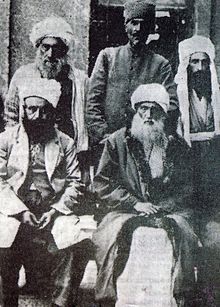Sceicco Said
Da Wikipedia, l'enciclopedia libera.

Lo Sceicco Said di Hınıs (in curdo شێخ سەعید, Şêx Seîd,[1][2]; 1865 – 29 giugno 1925) è stato un religioso curdo[3], principale leader della ribellione curda del 1925[4] e sceicco della confraternita Naqshbandiyya[5][6].
Biografia
[modifica | modifica wikitesto]Nacque nel 1865 a Hınıs da una famiglia influente dell'ordine Naqshbandiyya. Aveva cinque fratelli. Durante sua infanzia, la famiglia si stabilì a Hınıs, Erzurum, dove suo nonno era un influente sceicco.[7] Lo sceicco Said studiò religione presso la madrasa guidata da suo padre lo sceicco Mahmud Fevzi e da diversi studiosi islamici della regione.[8] Successivamente fu coinvolto nella tekke locale creata da suo nonno sceicco Ali.[7] Suo nonno era un rispettato capo della comunità religiosa e la sua tomba era visitata da migliaia di pellegrini.
Divenne capo della comunità religiosa dopo la morte del padre. Nel 1907 fece il giro delle vicine province dell'est e stabilì contatti con ufficiali della cavalleria Hamidiye.[7] Esortava i deputati curdi in parlamento a formare un loro partito. Nel 1923, fu avvicinato da Yusuf Zia Bey, che voleva che si unisse all'organizzazione segreta curda Azadî.[9] Divenne il capo dell'Azadî dopo che Zia Bey e Halid Beg Cibran, il capo dell'Azadî, furono denunciati dalla tribù Yormek e arrestati.[8] L'Azadi sarebbe diventata una forza trainante nella ribellione dello sceicco Said[10] che iniziò nel febbraio 1925 e, partendo da Piran, si diffuse presto fino ai dintorni di Diyarbakır.[11] L'esercito turco si oppose allora alla ribellione e fu catturato a metà aprile 1925 dopo essere stato circondato dalle truppe turche.[12] Fu condannato a morte dal Tribunale dell'Indipendenza a Diyarbakır il 28 giugno 1925 e impiccato il giorno successivo a Diyarbakır insieme a 47 dei suoi seguaci.[13] I suoi resti furono sepolti in una fossa comune anonima per impedirne la memoria da parte dei curdi.[14]
Vita privata
[modifica | modifica wikitesto]La sua prima moglie fu Amine Hanim, morta durante la guerra russo-turca. La sua seconda moglie era Fatma Hanim, una sorella di Halit Beg Cibran, il capo dell'Azadî.[8]
Suo figlio Abdülhalik morì dopo la sua deportazione in seguito alla ribellione dello sceicco Said.[15] Suo nipote Abdülmelik Fırat divenne deputato della Grande Assemblea Nazionale Turca.[16] Fırat affemò che i suoi antenati non furono coinvolti in politica fino a suo nonno, poiché avevano rapporti cordiali con l'élite ottomana.
L'attrice Belçim Bilgin è la sua pronipote.[17]
Note
[modifica | modifica wikitesto]- ^ (KU) Şêx Seîd û hevalê ey Amed hetê PAKî ra amê yadkerdene Kaynak: Şêx Seîd û hevalê ey Amed hetê PAKî ra amê yadkerdene. URL consultato il 22 December 2019.
- ^ (KU) شۆڕشی شێخ سهعیدی پیران. URL consultato il 22 December 2019.
- ^ Uğur Ümit Üngör, The Making of Modern Turkey:Nation and State in Eastern Anatolia, 1913-1950, p. 111, Oxford University Press, 2011, ...member of a Zaza family originally from Piran and revered sheikh of the Sharia Naqshbandi Sufi order...
- ^ Robert W. Olson, The emergence of Kurdish nationalism and the Sheikh Said Rebellion, 1880-1925, University of Texas Press, 1989, pp. 107, ISBN 978-0-292-77619-7.
- ^ (EN) Hakan Özoğlu, Kurdish Notables and the Ottoman State: Evolving Identities, Competing Loyalties, and Shifting Boundaries, SUNY Press, 12 febbraio 2004, pp. 94, ISBN 978-0-7914-5993-5.
- ^ Olson, Robert W. (1989), p.101
- ^ a b c Olson, Robert (1989), p.100
- ^ a b c Who’s Who in politics in Turkey (PDF), su Heinrich Böll Stiftung. URL consultato il 28 December 2020.
- ^ (DE) Günter Behrendt, Nationalismus in Kurdistan: Vorgeschichte, Entstehungsbedingungen und erste Manifestationen bis 1925, Deutsches Orient-Institut, 1993, pp. 373, ISBN 978-3-89173-029-4.
- ^ Olson, Robert W. (1989), p.101–102
- ^ (EN) Hakan Özoğlu, From Caliphate to Secular State: Power Struggle in the Early Turkish Republic: Power Struggle in the Early Turkish Republic, ABC-CLIO, 24 giugno 2011, pp. 89, ISBN 978-0-313-37957-4.
- ^ Olson, Robert W. (1989), p.115–116
- ^ Young Turk social engineering : mass violence and the nation state in eastern Turkey, 1913-1950 (PDF), su University of Amsterdam.
- ^ University of Amsterdam, https://pure.uva.nl/ws/files/867135/65687_13.pdf. URL consultato il 16 April 2020.
- ^ (EN) Ugur Ümit Üngör, The Making of Modern Turkey: Nation and State in Eastern Anatolia, 1913-1950, OUP Oxford, 1º marzo 2012, pp. 160, ISBN 978-0-19-164076-6.
- ^ (TR) Ecevit Kilic, CHP, dedemin gömüldüğü yere halkevi açtı, in Sabah, 27 ottobre 2008. URL consultato il 4 gennaio 2009.
- ^ (TR) 13 yaşında ölümle burun buruna geldim, su hurriyet.com.tr. URL consultato il 16 aprile 2020.
Voci correlate
[modifica | modifica wikitesto]Altri progetti
[modifica | modifica wikitesto] Wikimedia Commons contiene immagini o altri file su Sceicco Said
Wikimedia Commons contiene immagini o altri file su Sceicco Said
| Controllo di autorità | VIAF (EN) 57702288 · ISNI (EN) 0000 0000 2935 2959 · LCCN (EN) n88228591 · GND (DE) 129821357 |
|---|
Text is available under the CC BY-SA 4.0 license; additional terms may apply.
Images, videos and audio are available under their respective licenses.
